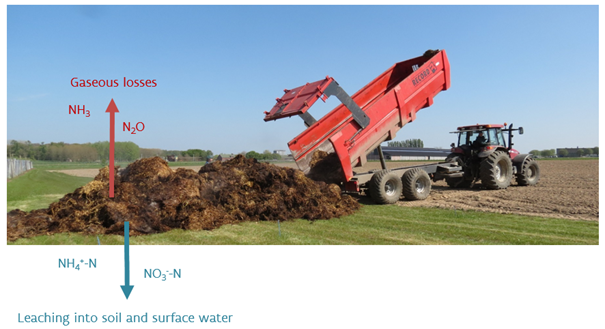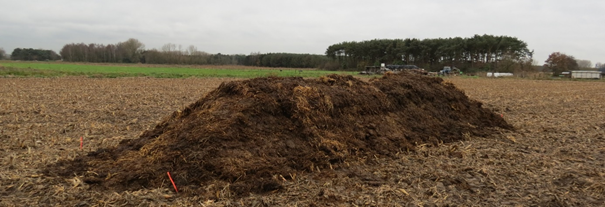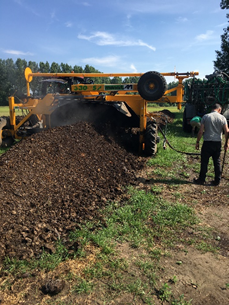In Belgian beef production systems, (finishing) beef stables are bedded with straw, resulting in a solid manure that is classified as such, i.e., having a dry matter content of minimum 20%. In the previous MAP legislation (in Flanders), in wintertime, it was mandatory to store manure in a concrete pit with collection of effluent. Storage on field was not allowed. This legislation did not only affect cattle farmers, but also arable farmers and horticulturalists.
In addition to the risk of leaching, there is also a risk of gaseous emissions and/or "burning" (prolonged heating) of the manure if not treated properly. The risk of leaching strongly depends on storage method, straw content of manure, variation in storage location, etc.
- Bottom of the pile: often too moist (nutrients leak away with manure juice)
- Top of the pile: often too dry and too airy (heating, N volatilisation)
- Slightly anaerobic storage
The best approach is to have a good, conditioned storage. This means; stack manure tightly, dam it and possibly moisten it slightly to maintain quality (cfr. potting shed system)

Emissions from manure storage in open air on field
For this, ILVO did research on different possibilities to reduce nutrient losses and enhance product quality by improvement of the storage conditions of manure on field. Due to this research, it is now allowed to store manure on field in wintertime when it is covered, however, only the amount that will be used on that specific field.
Is composting farmyard manure an option?
Potential benefits of composting:
- Volume reduction
- More homogenous and better spreadable product
- Faster plant nutrient effect
- Better suited to grassland, standing (perennial) crops
- Hygienisation
- Less risk of losses
- Increas soil C content / C-sequestration in the soil?
Is airtight sealing an option?
Potential benefits:
- No volatile losses during storage
- Preservation of contents and "energy"?
- What after opening?
ILVO did a trial at different sites, looking at the effects of just dumping versus composting manure, the latter by adding “brown residues” (chips from prunings, vegetation cuts from natural reserves) to the manure and looking at the effect of covering the piles, either by airtight sealing or semipermeable fleeces.

Soil quality measurements
Different measurements were taken to look at soil quality; Soil profiles on and adjacent to the heaps + reference situation, losses of moisture under the pile, and temperature of the soil under the heaps + reference situation.

Pile of manure during compost (uncovered) on field
Characterization of starting products and end products
Moisture and organic matter Fresh volume weight Organic matter % on dry weight (DM) Dry matter % Volumetric moisture content | Element contents and ratios pH, EC N, P, K, Ca N : P, C : P NO3--N, NH4+-N | Maturity and hygiene NO3--N : NH4+-N Oxygen uptake capacity (PLR) Biodegradability Germinating seeds |
In general, more mineral N was found under the piles with farmyard manure compared to the soil without manure. The amount of NH4+-N was higher compared to NO3--N (anaerobic conditions) and higher in the top layer (0-10 cm) compared to deeper layers. Two processes causing more N under manure piles: direct effect of N leaching from manure heap is the main cause and an indirect effect of elevated soil temperatures under heap (Soil temperature follows temperature in heap; up to 37°C in winter and max. 4.5 g Nmin/m² extra mineralisation in 0-10 cm top layer).
None of the different combinations tested showed substantial N leaching losses towards the soil, a maximum of 4.2% N, compared to the initial N content of the stored manure.
Adding 50 volume% of clippings (more structure and C-rich flow) lowers full moisture content and increases C/N, strongly reduces the quantity and N concentration in collected manure juice under the pile and achieve a decrease of 2,8% à 1,4% NH4+-N under heap compared to initial N in manure.

Cocompost of manure enriched with straw and brown residues from natural reserves
Different treatments advised, depending on the moist content
The most important factor to consider is the composition of the manure. Depending on the moisture content of the manure, a different treatment is advised:
- Wet, dense manure with a low amount of straw:
- No turning of the manure, as this will lead to more N loss by volatilisation and leaching
- When dumping on field, cover it with semipermeable fleece (eg. geotextile)
- More stable end product will be obtained when wood chipping are added or when co-composting
- Dry, loose manure with high levels of straw
- No dumping on field, but turned once and preferable moistened using a compost turner. This will lower N losses by leaching and volatilisation
So, looking at the characteristics of the manure, having initially a low volumetric moisture content and high C/N, more oxygen will be in the pile. More oxygen in the pile, means more microbial activity. This higher activity will lead to an increase in temperature in the pile, providing a more stable end product. Looking at the treatment, highest temperatures are obtained with extensive composting. Then with no treatment and covering with TopTex (commercial cover for compost). No treatment with no coverage will have a lower temperature, but no treatment with plastic will result in the lowest temperatures in the pile. Covering the pile will lead to less oxygen in the pile, and as explained above, oxygen leads to higher temperatures.
Conclusion |
1. Risk for N leaching during storage? - N leaching is only locally with max 4.2% of the initial N content of the manure, gaseous losses up to 50% - Mainly NH4+-N under the pile --> conversion to NO3--N after removal of the pile.
2. Avoiding N leaching after removal of the pile? - Aim for crop uptake in spring - Less fertilization required at this location - Do not store in the same location every year
3. Which storage method? - Depending on type of manure and desired end product, deposit loose or initially turn once, but always cover - Composting pure stable manure may not be appropriate |
Opportunities
Work together with nearby horticulturists/nature conservation organisations to collect tree clippings or with nature organisations for wood chips and grass clippings from natural areas. This collaboration can help to reduce costs, increases diversity and availability of material, and help in knowledge sharing.
Movie turning manure (Dutch): https://youtu.be/uUmL4DOeTzY
Research done by Koen Willekens (Koen.Willekens@ilvo.vlaanderen.be)
Contact person BovINE: Riet Desmet (Riet.desmet@ilvo.vlaanderen.be)